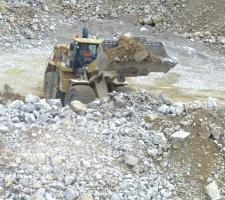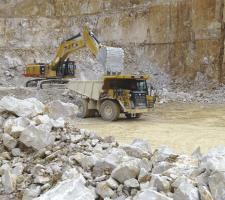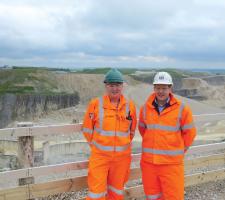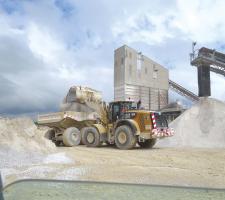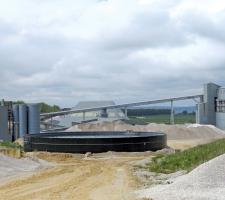Dowlow Quarry has been in operation since 1899, and at present it is set to go on for another 32 years. A plaque commemorating its centenary in 1999 is set into a wall in the quarry offices at Sterndale Moor, near the town of Buxton, in the heart of the Derbyshire Peak District national park, where quarrying has been a part of the culture for decades.
Adorning the walls are photographs of highlights of its past such as the old trucks, crushers, the quarry how it used to be, and the employees who have worked at this huge operation. An old small rail cart used for hauling material around the site years ago stands at the entrance.
A more recent photograph tells how pupils at a local school organised a competition and came up with Hurricane, Tornado, Stormy, Thunder, Lightning and Meteor as names for the huge
It is tradition in the industry to name such vehicles and a partnership with the neighbouring Earl Sterndale School offered the opportunity for pupils to come up with their ideas.
The huge limestone quarry site produces some 1.4 million tonnes/year, with some of the fine, clean material being supplied to Omya UK, part of a leading global producer of industrial minerals, mainly fillers and pigments derived from calcium carbonate and dolomite, and a worldwide distributor of specialty chemicals. It has one of its UK operations adjacent to the quarry site.
Initially lime was burnt at the Dowlow plant, and commercial production of industrial fillers began in 1979 under the auspices of Steetley Minerals, which was acquired by Redland before it in turn was bought by
Indeed, it was the
Claiming to be Britain’s leading independent producer of cement and ready-mix concrete, Hope also supplies aggregates and asphalt, and it was formed following the purchase of over 150 former Tarmac and Lafarge sites. These include the Hope cement plant (after which the company is named), which is near Dowlow Quarry, a national network of ready-mixed concrete plants, plus aggregates quarries, rail depots and asphalt plants.
The stone extracted at Dowlow Quarry is a carboniferous limestone over 180 million years old. Chemically a very pure form of calcium carbonate, the sedimentary rock is formed from compressed skeletons of millions of prehistoric animals and sea creatures.
One of the first jobs at the quarry after the acquisition by Hope Construction Materials was to look at the equipment, and this resulted in it investing in a huge new fleet of quarry machines in partnership with Caterpillar dealer
Finning provided a range of new technology, which it says will enable Hope to manage the new fleet to achieve maximum efficiency, flexibility and fuel efficiency.
And only recently, the group launched an Apprenticeship Academy seeking new talent to join its £300 million (€370 million) business in the Counties of Derbyshire and Yorkshire. It is appointing four new apprentices this year at Dowlow and Holme Hall (near Rotherham, Yorkshire) Quarries, and at the Hope cement works.
Dowlow Quarry, one of the biggest in the Hope group, is said to have little room for outward expansion within its present footprint although it can go down an estimated further six lifts. The existing site is already down six lifts in parts and it has permissions until 2046. It also has the mineral rights on land opposite the quarry entrance.
Each lift now is 15-17m although years ago it used to be 33m deep.
Material at the quarry is gained by drilling and blasting between two and three times a week and the total blasted is about 20,000-25,000tonnes.
“We have contract drilling and we do our own blasting,” says Eric Sutton, quarry supervisor, who has been at the quarry for 27 years.
The contractor uses an
The limestone rock is tipped into the primary crusher, a Sheepbridge 6050 that has been a feature at Dowlow for around 40 years, and which is at times handling up to 1,000tonnes/hour. Material is put into a clean pile and is fed up to the secondary crusher, a reversible Sheepbridge 3630.
Any dirty material goes to a pile and this is taken to the quarry’s washing plant using a series of conveyors where it goes through a barrel wash, and this comes out in various grades from dust to chippings. It also produces washed sand and unusually FGD, which is supplied to power stations.
The washing plant is fed with water from an on-site, one million gallon (4.55 million litres) water tank, which in turn is fed by a nearby borehole, and it also produces a by-product for which, at present, there is no use. This is disposed of on site, and some of it has been used as a layer during restoration around part of the rim of the quarry, which is an ongoing project.
“We are installing new filter presses at the washing stage and it may then be possible to use the ‘waste’ material for something,” says Eric Sutton.
Off the second crusher, Dowlow supplies clean material to Omya UK, which operates in a wide variety of industrial markets ranging from paper, plastics, rubber, coatings and adhesives through to building products, glass, food and agriculture.
It is a leading supplier of white minerals and chemicals both in the UK and around the world as part of Omya AG, a multi-national based in Switzerland.
The chippings and the 2-4mm dust produced at Dowlow go to the power stations, and although it produces a 75mm aggregate the next biggest size is 40mm and that is usually transported by road.
Other product sizes are 20mm, 14mm, 10mm, 6mm, 4mm, 2mm-0.
While some of the materials that leave Dowlow go by road the majority is taken out by train from the quarry’s own sidings using DB Schenker wagons.
Materials go to Ashburys railway station in Manchester, north-west England, and among customers are Eggington, Cottingham and Ferrybridge powers stations.
Materials are loaded onto trucks and wagons using one of Hope Construction Materials three new Caterpillar wheeled loaders, with the 988K said to have been the first in the UK when it was delivered.
The equipment deal with Caterpillar saw Hope make an entrepreneurial move by taking the operation of its new fleet of 21 Caterpillar machines in-house, supported by a bespoke fleet management package from Finning. The machines are being used at a range of Hope’s aggregates and cement sites across Counties Derbyshire, South Yorkshire and Bedfordshire.
With a focus on fuel efficiency, the new fleet at Dowlow Quarry consists of two 390DL ME excavators; four Caterpillar 740B articulated dump trucks (ADTs); four 775G DCA4 rigid dump trucks; two 980K wheeled loaders and one 988K wheeled loader.
Also part of the package were: a Caterpillar 962K high lift wheeled loader (Ashbury); four 775Gs; one TH407C telehandler and one TH4141C telehandler (all Hope cement works); two Cat 966K XE wheeled loaders (one at Holme Hall, Rotherham, County Yorkshire, one at Willington, County Bedfordshire); and one D6T LGP crawler tractor (Willington).
By combining these highly fuel efficient machines with training, telemetry and service support from Finning, Hope Construction Materials is aiming to highlight the benefits of taking an innovative in-house approach to fleet management. With a goal of achieving a significant reduction in cost per tonne, the new approach is a complete change, “set to give Hope a real advantage and profile for its different approach.”
As part of the multi-million pound fleet management package, Finning provided a full turnkey support package to Hope Construction Materials. This included on-site Eco-Drive operator training for Hope operators and site managers, equipment monitoring from its Finsight condition monitoring team and the use of the Vital Information Monitoring System (VIMS) data through Caterpillar’s MineStar system.
All of these solutions combine to help optimise production, and the over-riding fleet management package will cover every unit in the new fleet.
“As Britain’s leading independent supplier of cement, concrete, aggregates and asphalt, we made a conscious decision when we were formed in January 2013 to continually review the key elements of our operations,” says Simon Philips, managing director, Concrete, Aggregates and Asphalt Division, Hope Construction Materials.
“With our aim to become a reliable and responsible business, when it came to our mobile fleet strategy, we saw there was a clear opportunity to have a greater control and understanding of this key function. Following detailed analysis, we decided to bring the operation of our mobile fleet completely in-house. We wanted to take a new approach to fleet modelling that would allow us to optimise site by site, but also have the in-built flexibility to move equipment across our entire operations.
“So when we went out to the market, we were not just looking for the best purchase price of a machine, we wanted to work with a supplier that was much more aligned with our entrepreneurial approach to doing business.
“Finning was successful because it knew our quarry operations and worked with us to identify a complete fleet management package, integrating with our team and sharing knowledge. With access to the extensive Caterpillar range and finance from Cat Financial, Finning was not only able to match machine to machine, its team was also able to optimise the whole production and investment cycles.
“They looked at everything from haul roads, to our cost per tonne per litre on each part of our operation cycle. The Finning team also showed us how we could use services such as its Finsight condition monitoring team, to increase uptime and equipment performance.
“As a business, wherever possible we look to support our people and help them do their job better. So when Finning introduced us to Eco-Drive, we saw a clear opportunity to combine operator training with an enhanced fleet, to get the most out of our investment. Throughout the tender process, we felt we could place our trust in Finning to work with us and develop what will be the most fuel efficient fleet and operator team in the UK, backed by a solid support package.”
The new fleet is now being constantly monitored by the Finsight engineering team in Cannock, County Staffordshire, England.
“Since Hope Construction Materials was formed, we have worked closely with the business, fulfilling its requirements for equipment for short and longer term. Our UK branch network and in particular our Chesterfield branch, which is very close to Hope Works and Quarry and Dowlow Quarry, has been key to supplying operational support to the business,” says Dean Turner, the Finning customer account manager.
“Over a short period of time we have built strong working relationships across the whole business, understanding how it is looking to develop, its values and goals for the future. This led to us being invited to tender for the fleet deal. Throughout the tender process, we consulted with each site and the management team, to identify how we could add value and flexibility to the deal, bringing in colleagues from Caterpillar and Cat Financial.”
Financed by Cat Financial, the deal has given Hope the fleet flexibility it needs, with equipment selection taking into account the potential required to move units from one site to the next, to meet production needs.
“As Hope has seen, Finning and Caterpillar can combine our UK and global expertise to help customers optimise performance. In practical terms, what this actually means is that in addition to simply offering a managed fleet maintenance solution, including the supply of equipment, parts and service, we take a consultative, training-led approach,” says John Vardy, Finning general manager mining.
“For example, with Hope, our team has developed a site and equipment specific version of our Institute of Quarrying accredited Eco-Drive training programme, to help both operators and managers get the most out of the equipment in its working environment. This is coupled with detailed site surveys that include haul road impact profiling and general ongoing improvement programmes, backed up by equipment data analysis. Put together, this approach is used to continually optimise performance, helping Hope to benefit from its new investment now and into the future.”CRUSHING/SCREENING
1 x Sheepbridge =6050 primary crusher
1 x Sheepbridge 3630 secondary crusher
EXCAVATORS
2 x Caterpillar 390DL hydraulic excavators WHEELED LOADERS
2 x Caterpillar 980K wheeled loaders
1 x Caterpillar 988K wheeled loaderHauling
4 x Caterpillar 775G DCA4 off-highway trucks
2 x Caterpillar 740B ADTs


